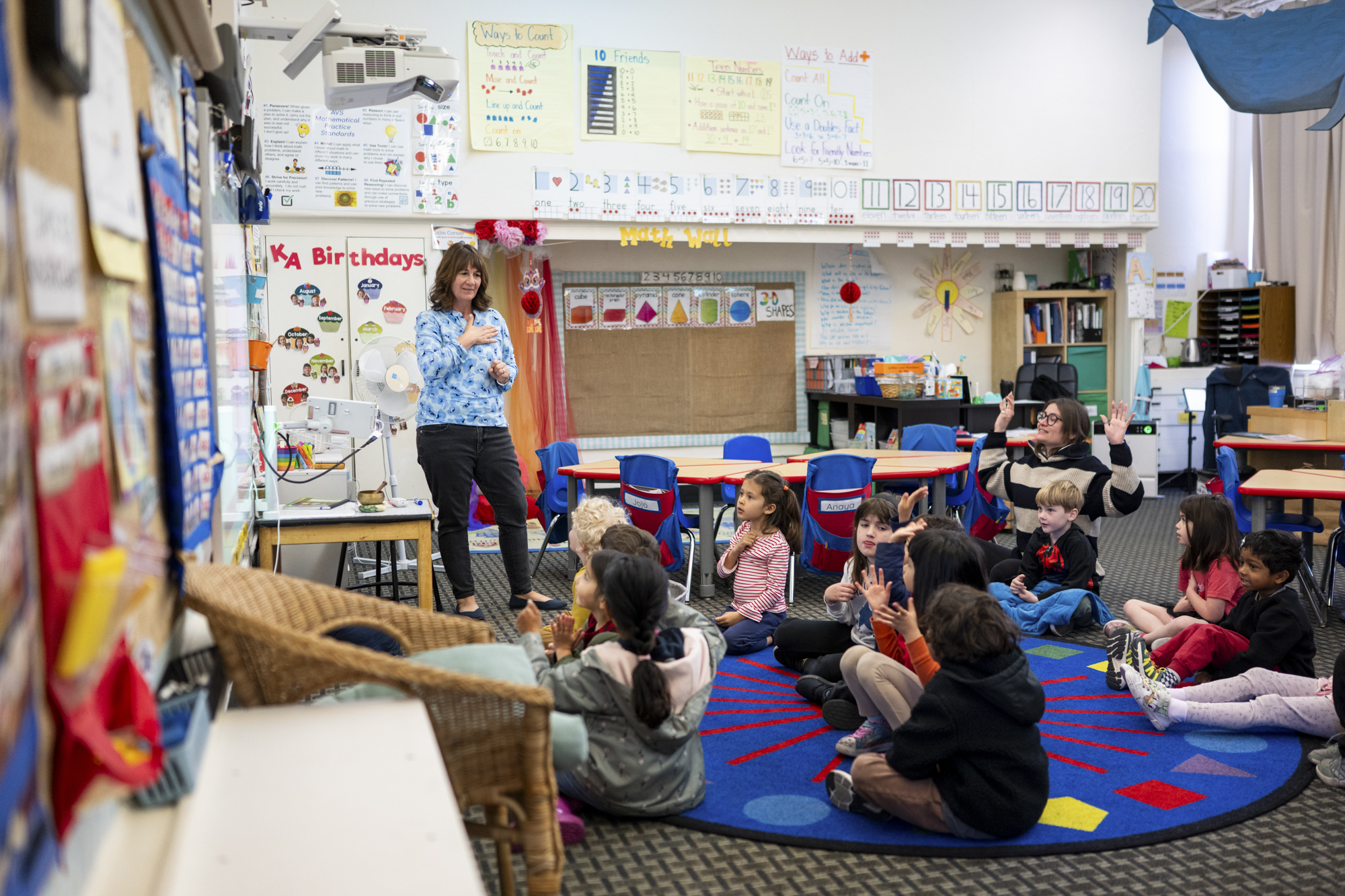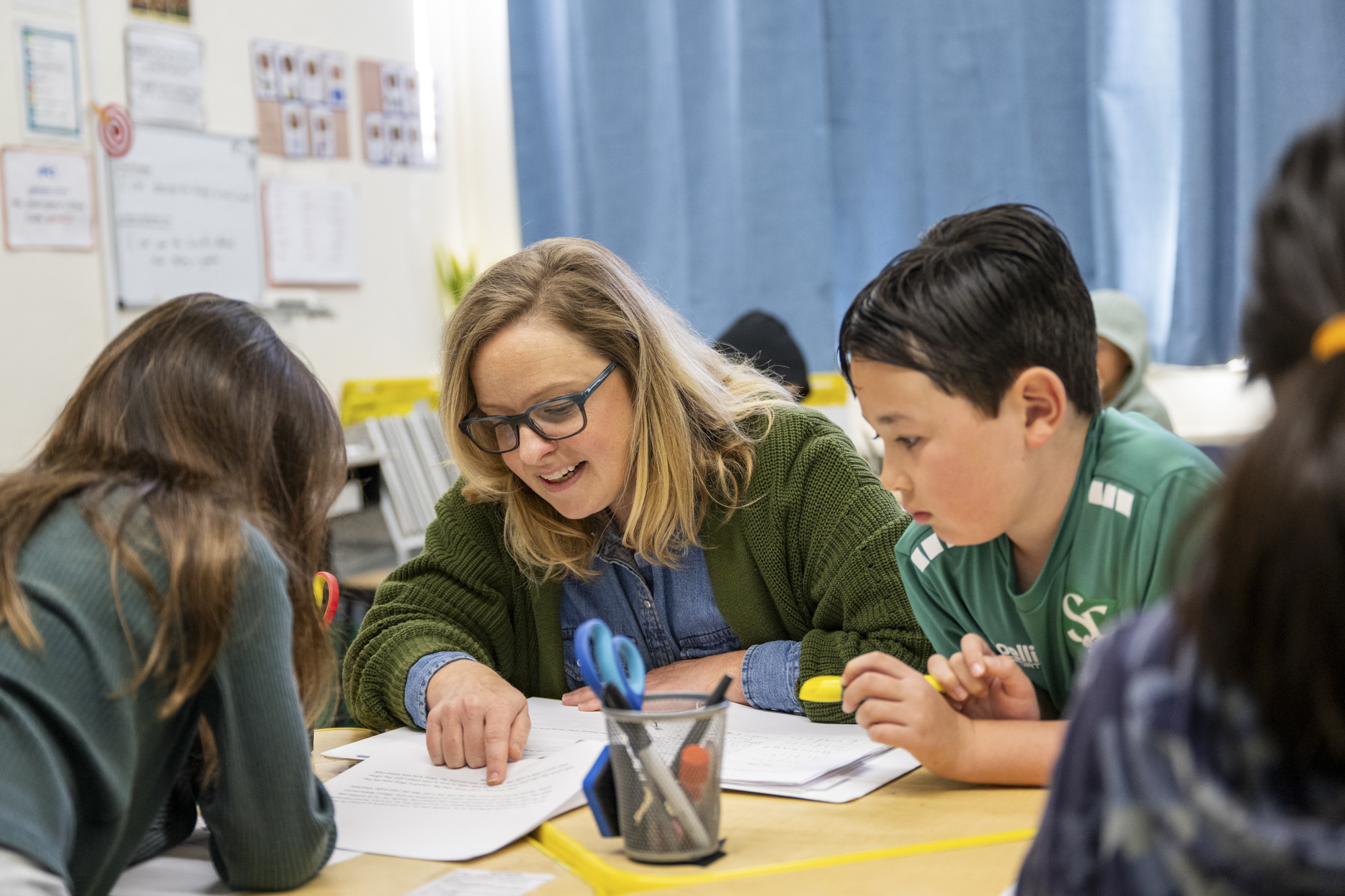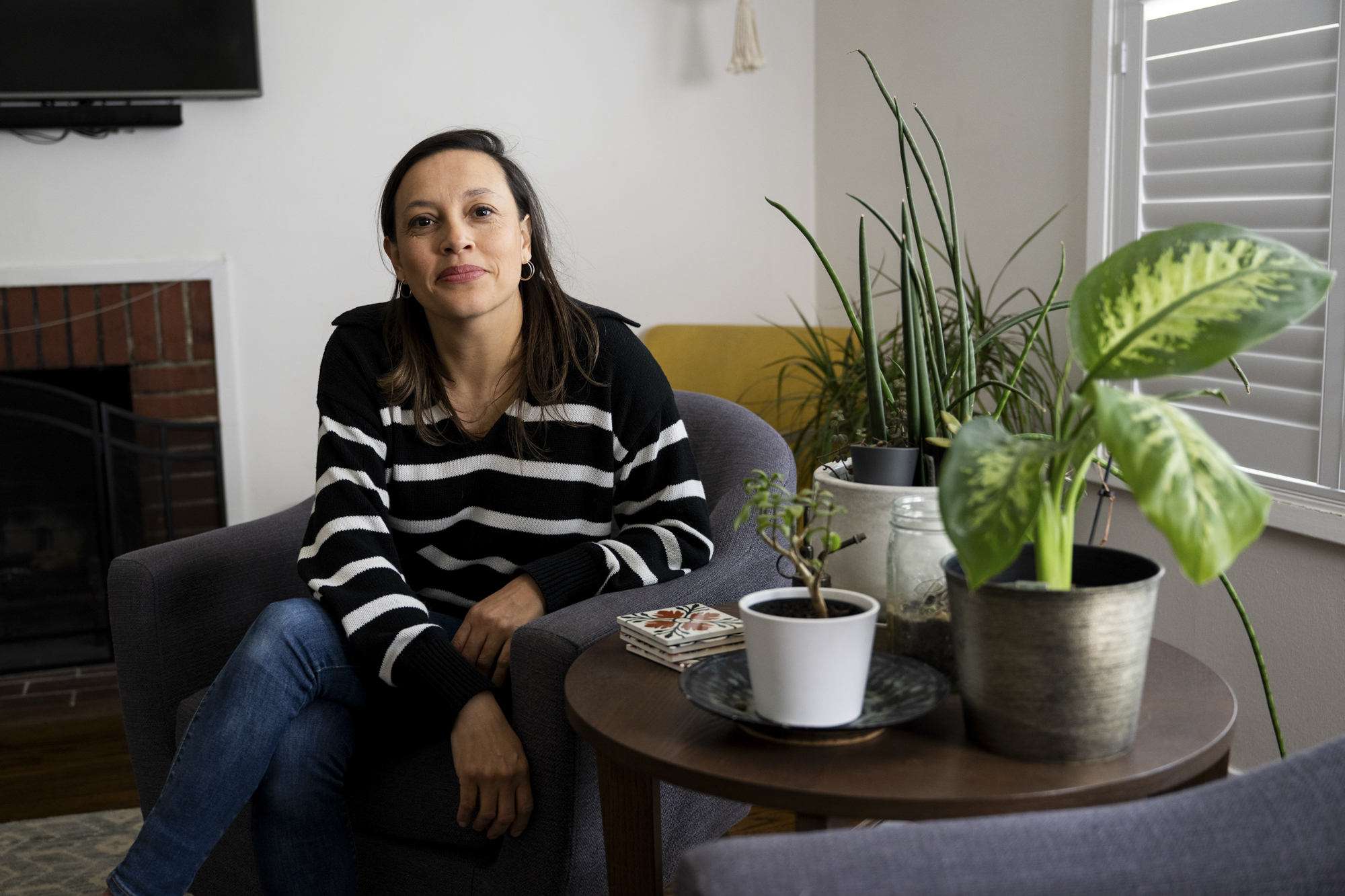Episode Transcript
This is a computer-generated transcript. While our team has reviewed it, there may be errors.
Katrina Schwartz: I’m Katrina Schwartz filling in for Olivia Allen-Price. Today on Bay Curious, we’re going to school.
Abby Gudich: So we’re out here on the schoolyard and we’re lining up for snack. It’s a beautiful San Francisco day.
Katrina Schwartz: To private school, Alta Vista, a K-8 school in the Portola neighborhood. Enrollment director Abby Gudich is showing us around.
Abby Gudich: So we have life size legos. We have an awesome play structure.
Katrina Schwartz: There’s a basketball court that’s been covered with soil and transformed into a garden.
Abby Gudich: See the kids back here picking herbs and making garden tacos.
Katrina Schwartz: Math and science are the focus here, through hands-on project based learning.
Abby Gudich: These are our engineering challenge projects and they had to design a tower to withstand wind. And they could only use recycled materials.
Katrina Schwartz: Private schools like this one are a popular option in San Francisco. Almost a third of K-12 kids go the private route even though it can cost anywhere from $10,000 to $65,000.
Michelle Boire: I just remember thinking this is so many schools, like there are so many schools here.
Katrina Schwartz: Bay Curious listener Michelle Boire was surprised when she saw a list of all the private schools in the Bay Area. She grew up on the peninsula in the early 2000s and says she remembers a few big college prep or Catholic schools. But now she says it seems like there are a lot more independent schools.
Michelle Boire: My question is, why are there so many private and independent schools in the Bay Area? And I guess I’m curious about the good, the bad, and the ugly. I’m very curious about all sides of why these exist.
Katrina Schwartz: Today on Bay Curious, we’re on a mission to unravel the complex and personal question of why families choose the schools they do. We’ll talk to private school parents, learn when the shift to private schools started and hear about some of the consequences for public schools and families. Stay with us.
Katrina Schwartz: To figure out why there are so many independent schools in the San Francisco Bay Area, we need to understand why so many parents choose to send their children to private school. Reporter Pauline Bartolone zeroed in on San Francisco where the numbers are highest to find out.
Pauline Bartolone: Michelle, our question asker, seems to be on to something. When I looked at the state data on enrollment at private schools many Bay Area counties are higher than the state average of 8%. Santa Clara, San Mateo and Marin counties are all at least double. But if you look at San Francisco, the private school numbers are staggering. Thirty percent of K-12 kids go to private school. Thirty percent. So, why are there so many private schools here? Well, because parents want them and there are enough people who can pay for what is often pricey tuition.
Aaron Rothman: I mean, it’s no secret, right? Public schools are not well funded in California, and that story isn’t getting any better.
Pauline Bartolone: Aaron Rothman and his wife have a teenage son, and they live in the Miraloma Park neighborhood of San Francisco. Aaron’s a recruiter in tech, and his wife is in the art business. When they decided to stay in the city to raise their child, Aaron says, they just factored in the cost of private school.
Aaron Rothman: We knew that probably fifth grade, you know, towards the end of elementary school, that we’re going to have to be thinking about this.
Pauline Bartolone: For elementary school, Aaron’s son went to his neighborhood public school, and had a great experience. But when it came to high school, Aaron says public schools may be good for high achievers or maybe kids with a lot of needs. But he worried his son would fall through the cracks.
Aaron Rothman: A large amount of the student population that sort of fell in the middle of the bell curve we felt was oftentimes just shuffled through in a way. And we were looking for something a little bit different.
Pauline Bartolone: So Aaron and his wife looked for a private high school where their son could get a little more attention and learning support. They chose a private Catholic school near them, even though they’re not religious. Aaron says he likes the variety of classes there, and the college guidance. And the school has so many ways to support students to get good grades.
Aaron Rothman: They almost sort of demand it in a way, whether it’s office hours in the morning, whether it was the opportunity to retake tests, whether it was the opportunity of having upperclassmen that were tutors.
Pauline Bartolone: The tuition is about thirty thousand a year, so Aaron says they make sacrifices. But he says it’s worth it. Their son, who is a junior now, is getting terrific grades.
Aaron Rothman: He’s thriving. He’s got straight A’s.
Pauline Bartolone: If you zoom out and look at the bigger picture of how schools are funded, the private school trend is more troubling. Economists say there are real consequences of siphoning students away from the public system. Tom Dee: There’s little doubt that if you have fewer kids, you expect to get less money.
Pauline Bartolone: Stanford education professor Tom Dee says public school districts receive state money based on how many kids are enrolled. So when parents choose to pull their kids out of public schools, the district loses out on funding. He says he saw the consequences of this when kids fled public schools during COVID.
Tom Dee: Many districts and I know San Francisco is among them are struggling with gut-wrenching decisions about which schools to close.
Pauline Bartolone: Tom says school buildings alone cost a lot to run.
Tom Dee: The lights still have to be on, the building still has to be heated. Also there’s certain staffing you might want in that school in terms of counselors and nurses and administration, etc., that are comparatively fixed even in the face of enrollment decline.
Pauline Bartolone: Thousands of kids did leave San Francisco schools in the past few years. The district says it gets $80 million less a year now because of it. On average that’s a loss of about twenty thousand per kid. But this private school trend in the city, it’s not a new phenomenon. Private school attendance in San Francisco has been very high for a long time.
Rand Quinn: It most certainly has roots in the desegregation process.
Pauline Bartolone: Rand Quinn once worked in San Francisco public schools. That experience inspired him to get a doctorate in education, and to write a book on the history of racial integration in the city during the late 1960s and 70s. In the beginning, kids were bussed out of their neighborhoods as a way to mix up each school’s student population.
Rand Quinn: When the courts demanded that San Francisco Unified School District desegregate, private school enrollment surged. And that this surge essentially created a permanent shift away from public education that we see today.
Pauline Bartolone: Busing wasn’t popular among any ethnic group, but research shows, white and Asian families were the most dissatisfied. Some parents believed that racial integration would lower educational standards. Tens of thousands of kids left San Francisco public schools over the next couple of decades.
Rand Quinn: There were robust options both in terms of Catholic schools and private independent schools for San Francisco families.
Pauline Bartolone: The flood of families opting out of the public system was the beginning of a negative cycle that’s been hard to reverse, Rand says. Kids leave, funding dwindles. The district responds by closing school buildings, maybe ending programs. Then, perhaps, cuts to staff make big news. The thinner the resources are at public schools, the more the community’s confidence in them erodes.
Rand Quinn: So even more families may opt out of the district and send their kids to private schools, especially middle class families with the means to leave. And so the burden of under-resourced schools falls disproportionately on working class and poor families.
Pauline Bartolone: Today, more than half of the students at San Francisco public schools are considered low-income or otherwise at risk. And total enrollment in the district is about half of what it was in the late 1960s.
Kendall Fleming: When people enter the public school system, I think they’re worried. I think they’re worried about the size of schools, the size of classrooms. They’re curious if the leadership can handle it. And our experience has just been a definitive yes.
Pauline Bartolone: Kendall Fleming lives in the Sunset neighborhood of San Francisco, and has two kids in the public elementary school there. She raves about their experience.
Kendall Fleming: We’ve been totally wowed by the teaching staff, the depth of knowledge, the comfort with the material.
Pauline Bartolone: She says her kids’ teachers are super invested. During a recent parent-teacher conference about her kindergartner, the teacher — who has a class of 22 students — talked about the facial expression of Kendall’s kid while she was learning to read.
Kendall Fleming: Teaching reading is very hard. They’re all different levels. They’re slightly different ages. And she knows enough about our child to know when our child is nervous and faking it, and then conquering it.
Pauline Bartolone: Kendall says she knows her experience may be different from other public school parents. The local school her kids attend has had a good reputation for a long time. Her kids feel safe there, and they’re proud to go to their school.
Kendall Fleming: There is so much to San Francisco schools that I think people may just not know about. And that’s a shame. I’m not sure it gets the credit it deserves.
Pauline Bartolone: But still, there are over a hundred private schools in San Francisco alone. At Alta Vista, for example, the K-8 private school you heard in the beginning of the show, they have small class sizes. This first grade class has 16 students, and two teachers. A public school nearby may have 22 kids, and one teacher.
These Alta Vista first graders are learning math but they’re not sitting stiffly in desks. They’re spread out in groups all around the room, learning addition using playing cards, rolling dice, and plastic toys. It may seem like an ideal learning environment. But the trade off is tuition here is more than $41,000 a year. And more than a third of the kids who apply here each year are rejected altogether. For some parents, choosing a school isn’t just about the teaching, it’s also about faith and morals. In the Bay Area, there are dozens of religious schools, and they tend to be less expensive than other private schools.
Sounds of Ada Bajada picking up her kid in the car
Pauline Bartolone: Ada Bajada has three kids in Christian schools. I went with her to pick up her youngest, at the same school Ada attended as a child.
Ada Bajada: I grew up in a Christian home, so my husband and I still go to church. We’re still practicing our faith. And so we wanted just that additional support with good fundamentals, morals, and just kind of raising our kids along the same ways that we were raised.
Pauline Bartolone: Ada grew up in the outer Mission District in the 80s and 90s where the threat of gang violence was real. She says her parents didn’t have a lot of money. Her mom worked at an insurance agency and her dad made pasta at a restaurant. But they found a way to pay.
Ada Bajada: My parents came from El Salvador during the war and so it was different. It was more about keeping us protected, like ultra protected.
Pauline Bartolone: Ada lives in South San Francisco now. There was a stabbing at the local high school recently. Like her parents, she’s worried about school safety, so she and her husband pay a total of $33,000 a year in school tuition for all three of her kids. She’s a nurse, and her husband is an electrician. And she says it’s 100% worth the money.
Ada Bajada: This is we consider an investment for them. It’s not something that we’ll be able to ever redo, no matter if we’re rich down the line or poor. So whatever we can invest in them to help develop them, secure them as a person inside and just help them so that their adulthood can be fruitful, then I think it’s a positive investment.
Pauline Bartolone: The choice to leave — or to stay — in the public school system is complex and so different parent to parent. To answer our question asker, Michelle, there are a lot of private schools in the Bay Area because there’s demand for them, and people here can afford to pay. But economist Tom Dee says, over time the trend can change basic notions about what we collectively pay for as a society.
Tom Dee: If fewer and fewer people are using public schools, they’re saying this is not a public good that matters to me. Why should I look fondly on income and sales taxes and property taxes that fund it.
Pauline Bartolone: Tom says, the school a kid goes to also affects how many opportunities they have to connect with people who are different from them.
Tom Dee: Just having intergroup contact is really important because when you just engage with people you’re more likely to see them as individualized humans and not through some kind of racialized stereotype.
Pauline Bartolone: Parents don’t have control over who their child sits next to at the school lunch table. But their decisions do have an impact on what schooling will look like in the future.
Katrina Schwartz: That was KQED reporter Pauline Bartolone. If you want to see the private schooling rate in your county, check out our website to see some maps and graphics we’ve put together. That’s at kqed.org. And while you’re there, sign up for our newsletter. In it we answer even more of your questions. Find it at kqed.org/baycurious.
Bay Curious is made in San Francisco at member-supported KQED. Our show is produced by Gabriela Glueck, Christopher Beale, and me, Katrina Schwartz. Extra support from Alana Walker, Maha Sanad, Katie Sprenger, Jen Chien, Holly Kernan and everyone on Team KQED. Some members of the KQED podcast team are represented by The Screen Actors Guild, American Federation of Television and Radio Artists, San Francisco Northern California Local. Have a great week!








